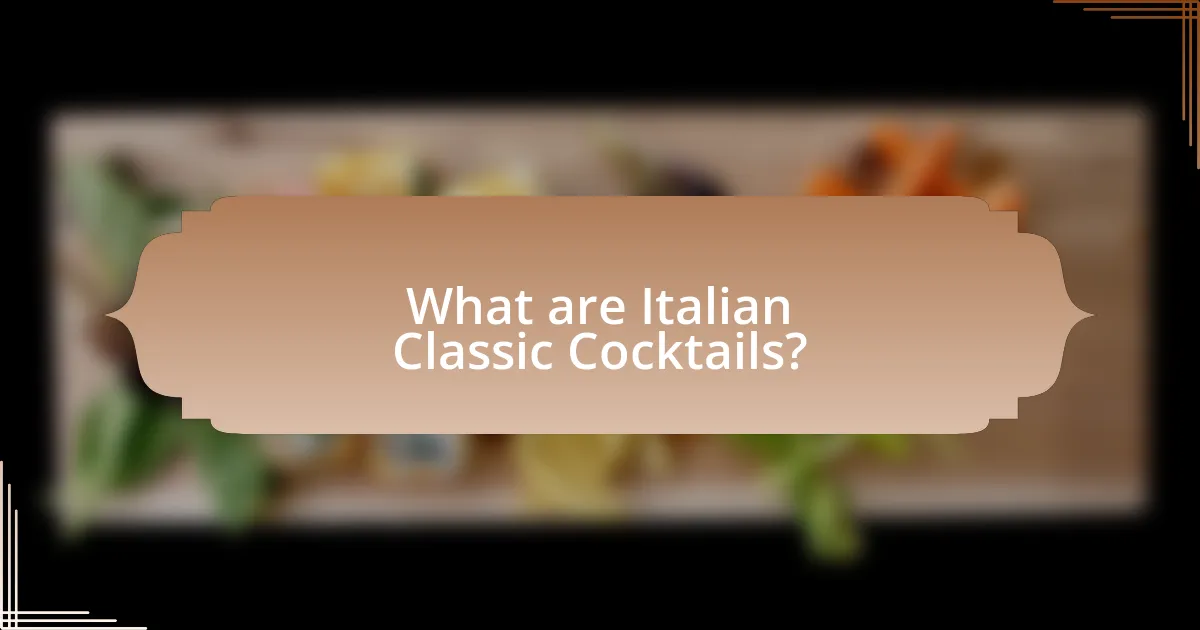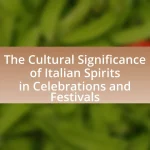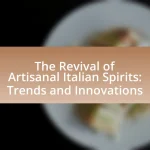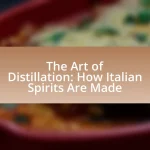Italian classic cocktails, such as the Negroni, Spritz, and Americano, are traditional drinks from Italy that embody a balance of bitter and sweet flavors, deeply rooted in the country’s aperitivo culture. Originating in the late 19th and early 20th centuries, these cocktails reflect Italy’s rich culinary heritage and have been influenced by historical events, including the Renaissance and Prohibition. The article explores the key ingredients, regional variations, and the significance of these cocktails in global drinking trends, while also examining how modern bartenders are reimagining these classics to cater to contemporary tastes through innovative techniques and ingredient substitutions. Additionally, it addresses the challenges of maintaining authenticity while adapting to evolving consumer preferences.

What are Italian Classic Cocktails?
Italian classic cocktails are traditional drinks originating from Italy that have become iconic in cocktail culture. Examples include the Negroni, which combines gin, vermouth, and Campari; the Spritz, typically made with Prosecco, Aperol, and soda water; and the Americano, featuring Campari, sweet vermouth, and soda. These cocktails are characterized by their balance of bitter and sweet flavors, often highlighting Italian spirits and liqueurs. The historical significance of these drinks is underscored by their popularity in Italian aperitivo culture, where they are enjoyed before meals to stimulate appetite.
How did Italian Classic Cocktails originate?
Italian classic cocktails originated in the late 19th and early 20th centuries, primarily in Italy’s vibrant bar culture. This period saw the emergence of iconic drinks like the Negroni and the Americano, which were crafted using local ingredients such as vermouth and bitters, reflecting Italy’s rich culinary traditions. The establishment of notable bars, such as Caffè Camparino in Milan, played a crucial role in popularizing these cocktails, as bartenders began to experiment with flavors and presentation, leading to the creation of timeless recipes that are still celebrated today.
What historical influences shaped these cocktails?
Italian classic cocktails have been shaped by various historical influences, including the cultural exchange during the Renaissance, the rise of aperitivo culture in the 19th century, and the impact of Prohibition in the United States. The Renaissance period fostered a blending of flavors and techniques from different regions, leading to the creation of iconic drinks like the Negroni. The 19th century saw the establishment of aperitivo as a social ritual in Italy, which popularized cocktails such as the Spritz. Additionally, Prohibition forced Italian bartenders to migrate to the U.S., where they adapted traditional recipes to local tastes, further evolving these cocktails. These historical contexts illustrate how Italian classic cocktails have been influenced by social, cultural, and economic factors over time.
Which regions in Italy are known for their classic cocktails?
The regions in Italy known for their classic cocktails include Veneto, particularly Venice, which is famous for the Bellini and Spritz; Lombardy, especially Milan, recognized for the Negroni; and Campania, where the Limoncello is a staple. Veneto’s historical significance in cocktail culture is highlighted by the creation of the Bellini in the 1940s at Harry’s Bar. Lombardy’s Negroni, invented in Florence but popularized in Milan, showcases the region’s influence on Italian mixology. Campania’s Limoncello, a lemon liqueur, is deeply rooted in local tradition and is often enjoyed as an after-dinner drink.
What are the key ingredients in Italian Classic Cocktails?
The key ingredients in Italian classic cocktails include vermouth, Campari, gin, and Prosecco. Vermouth serves as a fortified wine base, while Campari adds a bitter flavor profile. Gin contributes botanical notes, and Prosecco provides effervescence and sweetness. These ingredients are foundational in cocktails such as the Negroni, Americano, and Spritz, which have historical significance in Italian drinking culture, dating back to the 19th century.
How do traditional ingredients differ from modern substitutes?
Traditional ingredients in Italian classic cocktails are typically natural, locally sourced, and often handcrafted, while modern substitutes tend to be mass-produced, synthetic, or modified for convenience and shelf stability. For example, traditional vermouth is made from a blend of wine, herbs, and spices, reflecting regional flavors, whereas modern vermouth substitutes may use artificial flavorings and preservatives to enhance longevity and reduce production costs. This shift can alter the taste profile and authenticity of cocktails, as traditional ingredients contribute unique characteristics that are often lost in modern alternatives.
What role do bitters play in these cocktails?
Bitters serve as a crucial flavoring agent in Italian classic cocktails, enhancing complexity and depth. They contribute aromatic qualities and balance the sweetness of other ingredients, creating a harmonious flavor profile. For example, in cocktails like the Negroni, bitters complement the herbal notes of vermouth and the bitterness of Campari, resulting in a well-rounded drink. The use of bitters dates back to the 19th century, where they were integral to cocktail culture, underscoring their historical significance in mixology.
Why are Italian Classic Cocktails significant in cocktail culture?
Italian Classic Cocktails are significant in cocktail culture because they represent a foundational aspect of mixology, emphasizing balance, quality ingredients, and regional flavors. These cocktails, such as the Negroni and Spritz, have historical roots dating back to the 19th century, showcasing Italy’s rich culinary heritage and influence on global drinking trends. Their enduring popularity and the revival of traditional recipes in modern bars highlight their role in shaping contemporary cocktail practices, making them essential to understanding the evolution of cocktail culture.
How have these cocktails influenced global drinking trends?
Italian classic cocktails have significantly influenced global drinking trends by popularizing the use of high-quality ingredients and artisanal preparation methods. The resurgence of cocktails like the Negroni and Spritz has led to a broader appreciation for bitter flavors and aperitivo culture, encouraging bars worldwide to adopt similar offerings. This shift is evidenced by the increasing number of cocktail bars emphasizing craft cocktails, with a 30% rise in cocktail sales reported in the U.S. from 2015 to 2020, reflecting a growing consumer preference for sophisticated drinking experiences.
What makes Italian Classic Cocktails unique compared to other cocktail traditions?
Italian Classic Cocktails are unique due to their emphasis on high-quality, locally sourced ingredients and a balance of flavors that reflect Italy’s culinary heritage. This tradition often incorporates bitter liqueurs, fresh herbs, and citrus, creating complex profiles that distinguish them from other cocktail traditions. For example, the Negroni, made with equal parts gin, vermouth, and Campari, showcases the Italian preference for bittersweet flavors, a characteristic less prevalent in many other cocktail cultures. Additionally, Italian cocktails often emphasize aperitivo culture, promoting social interaction and enjoyment before meals, which is a distinctive aspect of Italian dining customs.

How are Italian Classic Cocktails being reimagined for modern palates?
Italian classic cocktails are being reimagined for modern palates through innovative ingredient substitutions, contemporary presentation styles, and the incorporation of local and seasonal flavors. Bartenders are experimenting with fresh herbs, artisanal spirits, and unique bitters to create variations that maintain the essence of traditional recipes while appealing to current taste preferences. For example, the Negroni is often updated with craft gin and infused vermouths, enhancing its complexity and freshness. This trend reflects a broader movement in the cocktail industry towards personalization and creativity, allowing for a diverse range of interpretations that resonate with today’s consumers.
What trends are influencing the reimagining of these cocktails?
Current trends influencing the reimagining of Italian classic cocktails include a focus on sustainability, the use of local and organic ingredients, and the incorporation of innovative flavor profiles. Sustainability drives bartenders to source ingredients responsibly, reducing waste and emphasizing seasonal produce. The trend towards local and organic ingredients enhances the freshness and quality of cocktails, appealing to health-conscious consumers. Additionally, innovative flavor profiles, such as the integration of unexpected herbs and spices, cater to adventurous palates, reflecting a broader movement towards unique and personalized drinking experiences. These trends collectively reshape traditional cocktails to align with contemporary consumer preferences.
How are flavor profiles being adapted to suit contemporary tastes?
Flavor profiles in Italian classic cocktails are being adapted to suit contemporary tastes by incorporating innovative ingredients and techniques that reflect current consumer preferences for freshness and complexity. Bartenders are experimenting with local and seasonal produce, utilizing herbs, spices, and unique bitters to enhance traditional recipes. For example, the Negroni has seen variations that include fruit-infused gins or the addition of craft vermouths, which cater to the modern palate’s desire for nuanced flavors. This evolution is supported by trends indicating a growing interest in artisanal and bespoke cocktails, as evidenced by a 2022 survey from the Distilled Spirits Council, which reported a 20% increase in consumers seeking unique flavor experiences in their drinks.
What new techniques are being employed in cocktail preparation?
New techniques being employed in cocktail preparation include the use of sous-vide infusions, clarified juices, and innovative carbonation methods. Sous-vide infusions allow for precise temperature control, enhancing flavor extraction from ingredients, while clarified juices provide a cleaner, more visually appealing drink by removing pulp and sediment. Innovative carbonation methods, such as using carbonation machines or CO2 chargers, create unique textures and effervescence in cocktails. These techniques reflect a trend towards precision and creativity in modern cocktail crafting, aligning with contemporary culinary practices.
What are some popular modern interpretations of Italian Classic Cocktails?
Some popular modern interpretations of Italian classic cocktails include the Negroni Sbagliato, which substitutes prosecco for gin, and the Espresso Martini, a twist on the classic espresso cocktail that incorporates Italian coffee flavors. The Spritz has also evolved, with variations using different aperitifs like Aperol or Select, and the Americano has seen adaptations with flavored bitters and artisanal vermouths. These reinterpretations reflect contemporary tastes while maintaining the essence of the original cocktails.
How does the Negroni evolve in modern bars?
The Negroni evolves in modern bars through innovative variations and ingredient substitutions that cater to contemporary tastes. Bartenders experiment with different spirits, such as gin alternatives like vodka or flavored gins, and incorporate unique bitters or vermouths to create new flavor profiles. For instance, the use of barrel-aged gin or the addition of herbal liqueurs has gained popularity, enhancing the complexity of the drink. This evolution reflects a broader trend in cocktail culture where classic recipes are reinterpreted to appeal to a diverse audience, as evidenced by the rise of craft cocktail bars that prioritize artisanal ingredients and creative presentations.
What innovative twists are being added to the Aperol Spritz?
Innovative twists being added to the Aperol Spritz include the incorporation of various flavored bitters, fresh herbs, and alternative sparkling wines. Bartenders are experimenting with ingredients like grapefruit or blood orange juice to enhance the drink’s citrus profile, while others are infusing the cocktail with fresh basil or rosemary for added complexity. Additionally, some variations utilize Prosecco alternatives, such as sparkling rosé or even hard seltzers, to cater to diverse taste preferences. These adaptations reflect a trend towards personalization and creativity in cocktail culture, appealing to modern palates seeking unique flavor experiences.

What are the challenges in reimagining Italian Classic Cocktails?
Reimagining Italian classic cocktails presents challenges such as maintaining authenticity while appealing to modern tastes. The balance between traditional ingredients and contemporary flavors can lead to dilution of the original cocktail’s character. Additionally, sourcing authentic Italian ingredients can be difficult due to availability and cost, which may compromise the cocktail’s integrity. Furthermore, consumer preferences have shifted towards lower alcohol and healthier options, necessitating adaptations that may stray from the original recipes. These factors highlight the complexity of innovating while respecting the rich heritage of Italian cocktail culture.
How do bartenders balance tradition and innovation?
Bartenders balance tradition and innovation by incorporating classic techniques and ingredients while experimenting with new flavors and presentation styles. For instance, they may use traditional Italian spirits like vermouth or amaro as a base but introduce modern elements such as unique bitters or artisanal mixers to create contemporary cocktails. This approach allows bartenders to honor the heritage of Italian cocktails while appealing to evolving consumer tastes, as evidenced by the rise of craft cocktail culture that emphasizes both authenticity and creativity.
What are the risks of altering classic recipes?
Altering classic recipes poses several risks, including the potential loss of traditional flavors and cultural significance. When classic recipes are modified, the original balance of ingredients may be disrupted, leading to a final product that lacks the intended taste profile. For instance, a classic Negroni relies on equal parts gin, vermouth, and Campari; changing the proportions or substituting ingredients can result in a drink that does not reflect the original’s complexity. Additionally, altering recipes can alienate purists who value authenticity, potentially diminishing the drink’s historical context and cultural heritage. This risk is evident in the cocktail community, where adherence to classic techniques and ingredients is often celebrated as part of the craft.
How do consumer preferences impact cocktail creation?
Consumer preferences significantly influence cocktail creation by dictating flavor profiles, ingredient choices, and presentation styles. As consumers increasingly seek unique and personalized experiences, bartenders adapt traditional recipes to incorporate contemporary tastes, such as using craft spirits, fresh ingredients, and innovative techniques. For instance, a survey by the Distilled Spirits Council found that 60% of consumers prefer cocktails that feature fresh ingredients, prompting mixologists to prioritize seasonal fruits and herbs in their creations. This shift not only reflects consumer desires for authenticity and quality but also drives the evolution of classic cocktails, ensuring they remain relevant in a competitive market.
What best practices should be followed when reimagining these cocktails?
When reimagining Italian classic cocktails, it is essential to prioritize balance in flavors, ensuring that no single ingredient overpowers the others. This approach maintains the integrity of the original cocktail while allowing for innovative twists. Additionally, using high-quality, fresh ingredients enhances the overall taste and appeal, as evidenced by the trend towards craft cocktails that emphasize artisanal components. Incorporating modern techniques, such as molecular gastronomy or unique infusions, can also elevate the drinking experience, aligning with contemporary preferences for creativity and novelty in mixology.
How can bartenders maintain authenticity while innovating?
Bartenders can maintain authenticity while innovating by respecting traditional recipes and techniques while incorporating contemporary flavors and presentation styles. This approach allows bartenders to honor the heritage of Italian classic cocktails, such as the Negroni or Spritz, while appealing to modern tastes through the use of innovative ingredients or unique serving methods. For instance, using locally sourced herbs or artisanal spirits can enhance the original flavors without compromising the cocktail’s identity. Historical context shows that many classic cocktails have evolved over time, indicating that innovation can coexist with authenticity, as seen in the resurgence of classic cocktails in modern bars that still adhere to their foundational elements.
What tips can enhance the presentation of modern Italian cocktails?
To enhance the presentation of modern Italian cocktails, focus on using high-quality glassware that complements the drink’s aesthetic. Elegant glass shapes, such as coupe or highball, can elevate the visual appeal. Additionally, incorporating fresh garnishes like herbs, citrus peels, or edible flowers adds color and texture, making the cocktail more inviting. Utilizing unique ice shapes, such as large cubes or spheres, not only chills the drink effectively but also enhances its visual impact. Finally, consider the use of vibrant mixers or layered ingredients to create a striking visual contrast, which can intrigue and attract the drinker.










